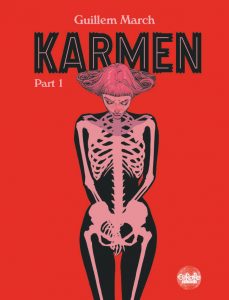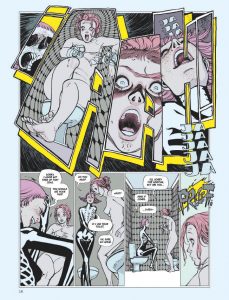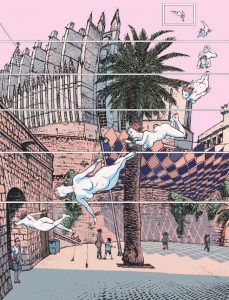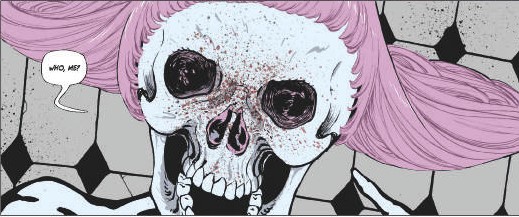
Karmen: Part 1
Story & Art: Guillem March
Coloring: Guillem March and Tony López
Lettering: Cromatik, Ltd.
Translation: Dan Christensen
Editor: Lisa Morris
Original Publisher: Éditions Dupuis
Digital, English-Language Publisher: Europe Comics
7,49€ (~$8.49)
Purchase Karmen: Part 1 here
Note: This comic contains graphic depictions of death, nudity, and suicide. Reader discretion is advised.
There is no shortage of happy grim reapers in comics. Death from Sandman, Botan from Yu Yu Hakusho, and Bernie from Death Vigil: all beautiful personifications for the beautiful hereafter. The newest member to the club is Karmen from Guillem March’s Karmen: Part 1. This book is the first of two volumes and the July Spotlight Title of the EUC Book Club, the comics club run by Europe Comics. Karmen’s silliness initially irked me as being more childish than charming. However, by the end of this book, Karmen’s attitude is revealed to be both skin deep and not, resulting in Karmen: Part 1 being an overall memorable story.
The story proper starts not with the somber-looking woman in a skeleton suit of the cover but with a love story. Cata and Xisco, two childhood best friends, live in Palma de Mallorca. Over the years, they appear to become more than just friends. A scene of a conflicted Xisco confiding about his impending break-up to another woman precedes Karmen’s arrival to Cata’s apartment in the narrative present. She finds Cata deathly white, naked, and with her wrists overflowing with so much blood that it pools on the bathroom floor. While my brain tries to process that cute child in pigtails I last saw is now this suicidal woman before me, Karmen performs a literal danse macabre for glassy eyed and still bleeding Cata. It is as Karmen thanks a crying Cata for her imaginary applause, my annoyance blooms.

To be clear, Karmen is not an unlikable character. She is actually quite sweet: she wraps Cata’s wounds and wants to help Cata with her strained relationships, especially her relationship with Xisco. However, her silly movie references, toilet humor, and vague answers were not amusing. It is a testament to the excellence of March’s linework and his and López’s coloring (the world looks as if seen from an Instagram filter making the already art more beautiful but also hyperreal) that I empathize with Cata so much that I want an immediate solution to her trauma and am unsatisfied when Karmen does not provide any meaningful assistance. Her smiles and jokes read as distracting. Karmen as a character is similar to Aladdin’s The Genie: they support the main character by providing resources to move the plot along while entertaining the audience. That is to say, they work best when the plot is established. There is no plot in this 160-page comic. Karmen: Part 1 is concerned more with story than plot. The story — and Karmen — really take off once Cata herself takes off from the ground, swimming through the city.
From the inventive and varied panel arrangements and page compositions to typography for onomatopeias drawn so as to visualize sound, March uses the comics medium to its full capacity. However, with the flying scenes, many of these inventive details are pulled back so we are left with a woman and a city. The results are pure magic. March, originally from Palma de Mallorca, renders the city with loving detail as to make it as much a main character as Arkham is in the Batman-verse. The setting is rendered not just realistically (as his sketches show) but with a fondness that makes it vivid.

March is equally attentive to anatomy. A quick view through his bibliography confirms that March holds the same mastery for feminine beauty as Milo Manara (incidentally, both also share the distinction of being criticized for hypersexualizing superheroines. To avoid any further digressions, I will instead direct you EIC Heidi MacDonald’s well-argued defense of March here). The soft fleshiness of Cata’s belly and thighs contrasting against the tan line from her bra and underwear, Karmen’s slanted eyes framed by a galaxy of freckles: so much characterization is told through simple, individual details. Karmen: Part 1 is first and foremost, a beautiful comic. After the flying scene, the story catches up with the artwork.
The flying scene features a brief interlude where Karmen handles another soul, and it is from here that the world-building and rules become established. Cata “encounters” Xisco as he discusses his break-up before Cata. She and Karmen reunite, and Karmen begins to fulfill her role, putting her over-enthusiasm and jokes aside for Cata’s character growth. Scenes of Cata processing her emotions and interacting with new side characters are vividly felt and effective. The addition of side characters Tony/Enrique and Karmela, contrasts to Cata and Karmen respectively, introduces Karmen as but one of many reapers in a larger system. Her motivation for her glibness laid bare, her prior demeanor reads as sincere. The character dynamics are more fleshed out, and the story becomes riveting. The façade drops and with it the stage is set for Karmen: Part 2. While I am confused as to why there is a Part 2, as it is only 63-pages long and contains all of the plot set-up in Part 1, The ending of Karmen: Part 1 is satisfying, having resolved enough questions about the setting and stakes to introduce Part 2, also available for purchase.
If you can handle a jarringly quick start to a slow-moving story, then I recommend Karmen: Part 1. The artwork is consistently inventive and fun and worth the price of purchase alone, especially for any self-taught comic artists wanting to learn from a master of the medium. Cata is a sympathetic, engaging character throughout, and while Karmen starts off as overwhelming, she eventually mellows into a three-dimensional character. Karmen marks March’s first solo, creator-owned comic series, and I would like to see more of his imaginative, surreal storytelling.








